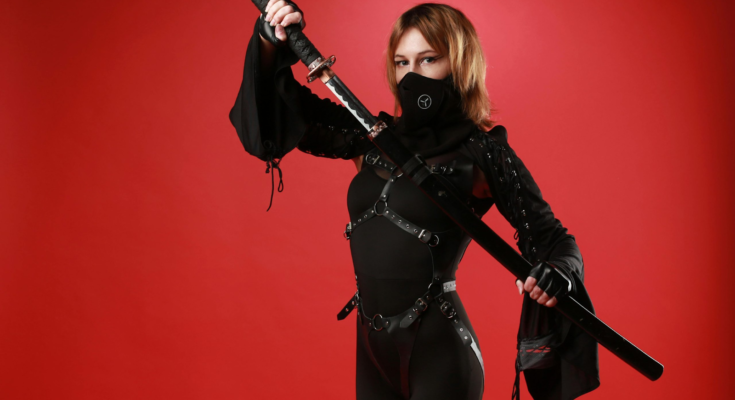The katana is a weapon that represents a historical narrative, a seamless fusion of fire and steel with centuries of traditional practices. With its elegant curve, razor-sharp edge, and distinctive circular guard, the Japanese sword maintains its position as Japan’s most revered weapon. Its image is inseparable from that of the samurai, the legendary warriors of feudal Japan. This unbreakable link raises a fascinating question: Why were only the samurai permitted to carry and use the iconic katana?
The answer is woven into the very fabric of Japanese society, reflecting a complex interplay of law, status, and spiritual significance. The katana was far more than just a weapon; it was a symbol of the samurai’s soul, an extension of their identity, and a clear marker of their elevated place in the social hierarchy. This guide will explore the historical context, legal restrictions, and cultural importance that made the katana an exclusive privilege of the samurai class.
The Rise of the Samurai Class
To understand the katana’s exclusivity, one must first understand the samurai. Emerging during the Heian period (794–1185), the samurai were a class of professional warriors who served Japan’s nobility. Over centuries, their influence grew, and by the feudal era, they had become the ruling military class. Their role was not limited to the battlefield; they were also administrators, politicians, and social elites who enforced law and order.
The samurai’s power was solidified under a strict social hierarchy known as the mibunsei. This system divided society into four main classes: samurai at the top, followed by farmers, artisans, and merchants. This rigid structure was designed to maintain stability, and the samurai’s position at its apex granted them immense authority and unique privileges, the most visible of which was the right to wear two swords—a long katana and a shorter companion sword called a wakizashi. This pair, known as the daishō, was the unmistakable badge of their rank.
A Sword with a Soul: The Symbolic Importance
For the samurai, the katana was not merely a tool of war. It was the physical embodiment of their honor and moral code, known as Bushido, or “the way of the warrior.” This philosophy emphasized virtues like loyalty, courage, and integrity. A samurai’s sword was considered an extension of their being, a sacred object to be treated with the utmost respect.
The deep spiritual connection is reflected in the intricate process of katana forging. A handmade katana required weeks or even months to create, a painstaking process involving a master swordsmith (katana-kaji) and their apprentices. The process began with selecting high-quality steel (tamahagane), followed by repeatedly heating, hammering, and folding the metal to purify it and create thousands of layers. This layering technique gave the blade its legendary strength and flexibility. The creation of the blade’s distinctive temper line, or hamon, through differential heat treatment was a moment of profound spiritual importance. This fusion of artistry and metallurgy elevated the Japanese sword beyond a simple weapon into a work of art and a sacred artifact.
The Sword Hunt: Legal and Social Rules
The restriction of katana ownership was formally codified through a series of edicts. The most significant of these was the “Sword Hunt” (Katanagari) of 1588, issued by the powerful warlord Toyotomi Hideyoshi. This decree ordered the confiscation of weapons from all non-samurai classes, including farmers, monks, and merchants.
The stated reason for the Sword Hunt was to prevent peasant uprisings and ensure social stability. By disarming the populace, the ruling class effectively removed the means for violent rebellion. Socially, the act of carrying a katana became the ultimate status symbol. It visually separated the samurai from everyone else, instantly communicating their authority and their right to enforce the law—even to the point of using lethal force. This privilege, known as Kiri-sute gomen (“permission to cut down and leave”), allowed a samurai to strike down a commoner who had offended them, though this right was used sparingly and came with legal scrutiny.
The Art of the Sword: Rigorous Training and Skill
Wielding a katana effectively required immense skill and discipline. Samurai began their training in swordsmanship, or kenjutsu, from a young age. This rigorous training was not just about combat techniques; it was a holistic discipline that cultivated mental focus, physical control, and spiritual awareness. They learned how to draw the sword, strike, and return it to its scabbard in a single, fluid motion—an art form in itself.
Because this specialized training was exclusive to the samurai class, they were the only ones who possessed the skill to use the katana to its full potential. A commoner who somehow acquired a katana sword would lack the years of dedicated practice needed to handle it properly, making it more of a liability than a weapon in their hands. This practical reality reinforced the social and legal restrictions on its ownership.
Debunking Common Misconceptions
While the rule was strict, there were occasional exceptions. Some non-samurai individuals, such as certain high-ranking officials or merchants who provided significant services to a samurai lord, might be granted special permission to carry a sword. Additionally, some martial arts schools (ryū) outside the direct samurai lineage taught swordsmanship, but their members would not have carried their blades in public as a samurai would.
A common myth is that every sword from this period was a masterfully crafted katana of immense katana value. In reality, the quality of swords varied greatly. While the finest blades were reserved for high-ranking samurai, lower-ranking warriors often carried mass-produced, lower-quality weapons.
A Legacy Forged in Steel
The era of the samurai officially ended with the Meiji Restoration in 1868, which abolished the feudal system and the samurai class. The Haitōrei Edict of 1876 prohibited the public carrying of swords, effectively ending the katana’s role as a symbol of status.
Despite this, the legacy of the katana and the samurai endures. The samurai sword remains an object of fascination worldwide, a powerful symbol of Japanese culture, history, and the pursuit of perfection. It stands as a testament to a time when a weapon could also be a work of art, a status symbol, and the very soul of its wielder.
The Enduring Symbol of Honor
The reasons why only samurai were allowed to use a katana are rooted in a system designed to maintain social order and reinforce a strict class hierarchy. The katana was more than just a weapon; it was a potent symbol of the samurai’s authority, honor, and unique place in Japanese society. Through legal decree, specialized training, and deep cultural significance, the katana became an exclusive emblem of the warrior class. Its story is a piece of living history, a narrative of power, artistry, and a code of honor forged in steel.




